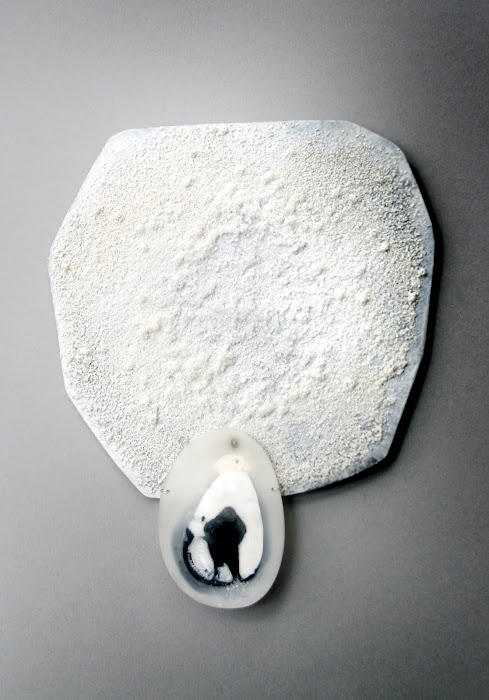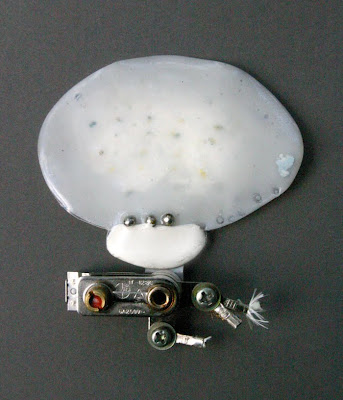 1. Enamel added, waiting for the kiln
1. Enamel added, waiting for the kilnNow here's a piece of work I have quite mixed feelings about!
This piece is based on a simple black and orange close-up portrait of a cajon player, and while the design, model making and welding of the mild steel for the pendant went all smoothly, the rest of the process was riddled with trouble. Or shall we say CHALLENGE.

 2. Fired pendant with enamel painted and fired orange back3. The textured back of the main pendant part
2. Fired pendant with enamel painted and fired orange back3. The textured back of the main pendant partAfter firing the main pendant, everything was looking OK and I liked the textured back that shows the brushstrokes as dark marks on oxidised steel. I would have been happy to leave the design at this, but thought that an extra layer would bring solidity, and I could avoid riveting the necklace attachment directly onto the pendant.
 3. Back of the back, clear liquid enamel on steel, 925 attachments soldered
3. Back of the back, clear liquid enamel on steel, 925 attachments solderedSoldering the silver bars to the back of the orange base (seen from the front, painted with orange, red and yellow enamel paints), to be riveted to the pendant, however was a real adventure: I had to use IT solder for it to last the heat of a kiln. On steel, making the "harder than hard" IT solder go required a true blast of heat. Luckily, nothing melted though – at this stage.
Then it came to riveting the pendant onto the base. It had warped slightly due to the many layers and firing process, so the rivets had to be firm and a little longer than usual to keep the pieces together safely and without bending the parts, thus risking breakage of the enamel layers. First I tried to hammer the ends of the rivets (1.2 mm 925 wire with 18c gold balls at the ends; this too was a bit of an accident, but gold's not so bad ; ), but found that I couldn't position the pendant anywhere securely enough, for the brisk and accurate hammer blows the riveting process requires. This I'm sure is dependent on my skill level, not the actual logistics of the piece, but neverthless, it was late at night, and …
 5. The same back, after some … eventful events …
5. The same back, after some … eventful events …At this stage I'd used microtorch exactly once in my life. Somehow, in my desperation, I got an idea to ball BOTH ends of the wire. We had talked about this, speculating if it would work neatly should the rest of the piece be immersed in water. But no time for water at this stage, straight to the flame! The first rivet was successfull … until I smelled something burning … Yes, it was the orange enamel paint on the other side I'd forgotten about!!
I took a look and had to be optimistic in those "am" hours; I thought that a bit of flaking and ash might look OK. Hehe. "The fire of flamenco"??!
So then I decided to ball the rest of the rivets, too. What the heck! I could always repaint the enamelled orange side, as I ended up doing. But for some reason, the wire would not make a ball this time, no matter how hot I had the microtorch flame on! I even tried with a bigger torch, but to no avail. Everything just melted into soft hills. So, I decided that this shall be the look, then. Don't anyone dare call me a perfectionist, or INflexible! : P The final rivet is hammered in a traditional way, it was in the outside edge of the layers, so I could somehow manage.
After this treatment, the beautiful back was stained with black marks and melted silver. You can kind of see that for yourself in the photo. I thought that a slight sand / polishing might help it look more together, and was happily surprised that the marks from enamelling still came through after emerying the back quite heavy-handedly. Otherwise, it's a mess! : D
And the chain?
I made one, but am not happy with it really. So I'll re-make it over the break, and then present before and after images.
xx IK






















































